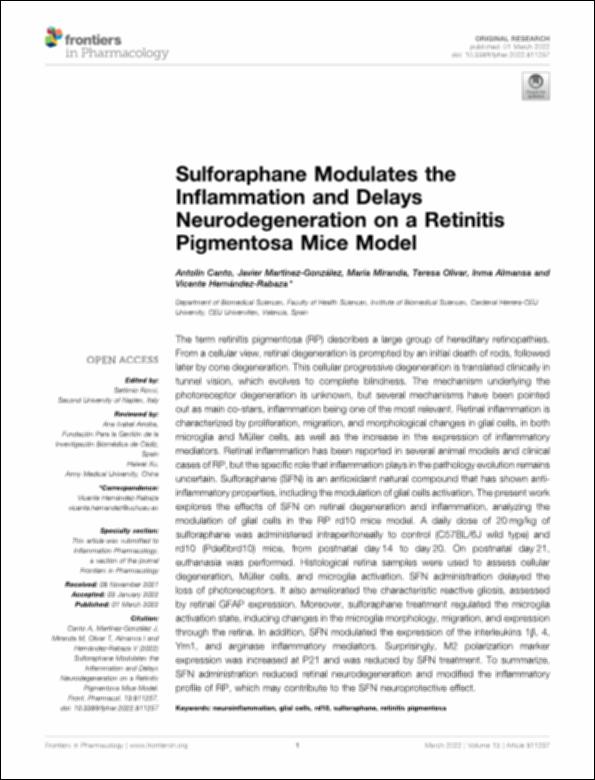Please use this identifier to cite or link to this item:
http://hdl.handle.net/10637/14021Sulforaphane modulates the inflammation and delays neurodegeneration on a Retinitis Pigmentosa mice model
| Title: | Sulforaphane modulates the inflammation and delays neurodegeneration on a Retinitis Pigmentosa mice model |
| Authors : | Cantó Catalá, Antolín Martínez González, Javier Miranda Sanz, María Olivar Rivas, Teresa Almansa Frías, María Inmaculada Hernández Rabaza, Vicente |
| Keywords: | Retinitis pigmentaria - Tratamiento.; Sulforaphane - Therapeutic use.; Retinitis pigmentosa - Treatment.; Retina - Diseases - Treatment.; Sulforafano - Uso terapéutico.; Retina - Enfermedades - Tratamiento. |
| Publisher: | Frontiers Media |
| Citation: | Canto, A., Martínez-González, J., Miranda, M., Olivar, T., Almansa, I. & Hernández-Rabaza, V. (2022). Sulforaphane modulates the inflammation and delays neurodegeneration on a Retinitis Pigmentosa mice model. Frontiers in Pharmacology, vol. 13, art. 811257 (01 mar.). DOI: https://doi.org/10.3389/fphar.2022.811257 |
| Abstract: | The term retinitis pigmentosa (RP) describes a large group of hereditary retinopathies. From a cellular view, retinal degeneration is prompted by an initial death of rods, followed later by cone degeneration. This cellular progressive degeneration is translated clinically in tunnel vision, which evolves to complete blindness. The mechanism underlying the photoreceptor degeneration is unknown, but several mechanisms have been pointed out as main co-stars, inflammation being one of the most relevant. Retinal inflammation is characterized by proliferation, migration, and morphological changes in glial cells, in both microglia and Müller cells, as well as the increase in the expression of inflammatory mediators. Retinal inflammation has been reported in several animal models and clinical cases of RP, but the specific role that inflammation plays in the pathology evolution remains uncertain. Sulforaphane (SFN) is an antioxidant natural compound that has shown antiinflammatory properties, including the modulation of glial cells activation. The present work explores the effects of SFN on retinal degeneration and inflammation, analyzing the modulation of glial cells in the RP rd10 mice model. A daily dose of 20 mg/kg of sulforaphane was administered intraperitoneally to control (C57BL/6J wild type) and rd10 (Pde6brd10) mice, from postnatal day 14 to day 20. On postnatal day 21, euthanasia was performed. Histological retina samples were used to assess cellular degeneration, Müller cells, and microglia activation. SFN administration delayed the loss of photoreceptors. It also ameliorated the characteristic reactive gliosis, assessed by retinal GFAP expression. Moreover, sulforaphane treatment regulated the microglia activation state, inducing changes in the microglia morphology, migration, and expression through the retina. In addition, SFN modulated the expression of the interleukins 1β, 4, Ym1, and arginase inflammatory mediators. Surprisingly, M2 polarization marker expression was increased at P21 and was reduced by SFN treatment. To summarize, SFN administration reduced retinal neurodegeneration and modified the inflammatory profile of RP, which may contribute to the SFN neuroprotective effect. |
| Description: | Este artículo se encuentra disponible en la página web de la revista en la siguiente URL: https://www.frontiersin.org/articles/10.3389/fphar.2022.811257/full |
| URI: | http://hdl.handle.net/10637/14021 |
| Rights : | http://creativecommons.org/licenses/by/4.0/deed.es |
| ISSN: | 1663-9812 (Electrónico) |
| Issue Date: | 1-Mar-2022 |
| Center : | Universidad Cardenal Herrera-CEU |
| Appears in Collections: | Dpto. Ciencias Biomédicas |
Items in DSpace are protected by copyright, with all rights reserved, unless otherwise indicated.


